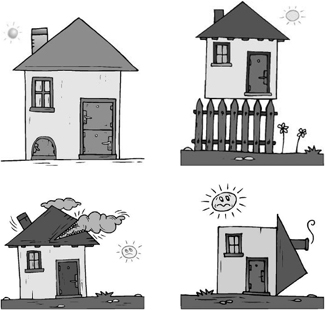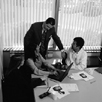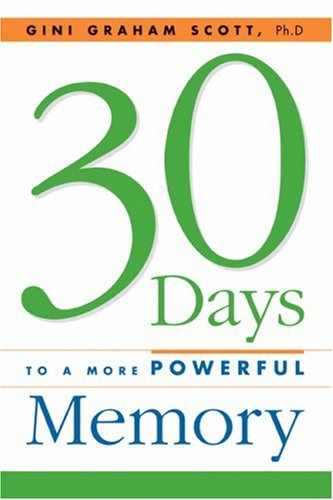When you learn any kind of new subject or skill, to see how much you have improved, it’s good to see where you started from. So this chapter is designed to provide you with a baseline showing how you feel about your ability to remember now and how you perform on different types of memory tests. Then, you can repeat the tests after you finish this book and examine the changes. You should expect to do better the second time.
These tests will give you a general idea of where you are now, though they are not scientific tests. The first test depends on your honest assessment of your memory abilities, and it depends on both your own candor and how accurately you make your assessment. If you approach the test with a similar attitude both times you take it (now and after 30 days), you should be reasonably accurate in assessing your own feelings and perceptions about your memory.
In the second set of tests, there is a problem with taking exactly the same test as a before-and-after test, because anything you remember about the first test will improve how you do on the second one. I have tried to overcome this problem by giving you similar types of tests to take before and after you read the book, so you can compare your score. Using the techniques you have learned, you should do better after 30 days.
Keeping those cautions in mind, here are the tests. I have drawn inspiration from the memory tests in a dozen different books on memory, but I have mostly come up with my own items. For the objective tests, there is a before-and-after set for each test. Just look at the first set you are taking—and wait until you have finished the book to take the second set. Otherwise, if you look at the second set now, you may influence your results when you take the test again and therefore any improved results won’t be valid.
This first test will provide you with a baseline measure of your feelings about how good your memory skills are right now.
The following test is designed for you to subjectively reflect on your memory abilities now. Make an extra copy of this test, so you can answer it again after you have spent a month working on improving your memory. That way, you can monitor any improvement. The first time you take the test, answer each question as honestly as you can and total up your score. This will help you notice the areas where you especially need to work on memory improvement, such as learning to pay better attention, increasing your ability to encode information, and improving your ability to retrieve names, faces, places, and dates. Rate your memory on a scale of 1 (you forget most or all of the time) to 5 (you typically remember very well), and then obtain an average for each category (total up the ratings in that category and divide by the number in that category).
TEST #1: RATING MY MEMORY |
|---|
My Overall Memory _______ |
My Memory for Everyday People, Places, and Things[1] _______ (average of my scores for the categories below) People’s names _______ People’s faces _______ Where I put things (e.g., keys, eyeglasses) _______ Performing household chores _______ Directions to places _______ Personal dates (i.e., birthdays, anniversaries) |
My Memory for Numbers _______ (average of my scores for the categories below) Phone numbers I have just looked up _______ Phone numbers I use frequently _______ Bank account numbers _______ Computer passwords _______ Combinations for locks and safes _______ |
My Memory for Information _______ (average of my scores for the categories below) Words _______ What someone has told me in a conversation _______ What I have learned in a classroom lecture _______ Reading a novel _______ Reading a nonfiction book _______ Reading an article _______ Reading the newspaper _______ |
My Memory for Activities _______ (average of my scores for the categories below) Appointments _______ Performing household chores _______ Shopping for items at a store _______ Speaking in public _______ A meeting at work _______ |
My Memory for Events _______ (average of my scores for the categories below) Earlier today _______ Yesterday _______ Last week _______ Last month _______ 6 months to a year ago _______ 1–5 years ago _______ 6–10 years ago _______ When I was a child _______ |
After you finish rating each particular item, find the average for remembering that type of information. Then, look at your ratings to assess how well you are doing in different areas. Commonly, you will find you remember best those things that are most important to you, since you naturally pay more attention in those areas. But, where are you especially weak? Those are areas ripe for improvement.
Use this test as a guide to help you determine where you especially want to increase your memory. Later, after you have worked on developing your memory over the next month (or however long you take to do this), retest yourself without looking at how you rated yourself before. Afterwards, compare your before-and-after ratings. Generally, you will find you improve, though your subjective ratings can be affected by other factors, such as how you are feeling when you take the test.
In any case, your second set of scores can help you decide what you want to work on next if you want to continue to improve your memory. In fact, if you’re into charts and graphs, you can plot your ratings every month to chart your continued progress.
The following objective tests are other ways of testing your memory for different types of information. Some of these tests will also show how well you can avoid interference from similar types of information. Again, determine your scores now, and test yourself a second time in 30 days to see your progress. And if you continue to work on improving your memory, try testing yourself every 30 days. To avoid the effect of remembering what you have previously learned from a test, test yourself with an alternate version of the test (such as new sets of words and faces). You can use Set 2 for your second test or work with a friend or associate to create another version of the test for each other. (For example, ask a friend to come up with a list of 10 random words for you to remember.)
This is a classic test that memory researchers use—you are presented with a list of random words (or words in a certain category), and then you have to recall as many as you can, or you have to recognize whether they are in another list. Here are series of word tests, and you can easily have a friend or associate come up with additional word tests for you. See how well you can do under different conditions. There are two sets—one to test yourself now, the other to test yourself later. Get a sheet of paper and a pencil to write down your answers and scores.
Take a minute to look at the following list of words; then close the book, and see how many you can write down correctly from your memory in a minute or two. Then, when you finish, look in the book and score 1 point for each correct word, subtract 1 point for each incorrect word, and total your score.
IMMEDIATE RECALL TEST | |
|---|---|
Set 1: To Test Yourself Now | Set 2: To Test Yourself in 30 Days |
Pencil | Animal |
Wood | Fox |
House | Court |
Book | Movie |
Television | Pen |
Box | Circle |
Lamp | Elevator |
Couch | Farm |
Night | Factory |
Moon | Wall |
Now see how well you can do when you engage in another activity before testing your recall. As in the first test, take a minute to look at the following list of words, then close the book. But before you try to recall, do something else for 20 minutes. Do whatever you want, such as taking a walk, reading a newspaper, having a snack, or shooting baskets in your backyard. Just don’t think about the words on the word list. Then, see how many words you can write down correctly from your memory in a minute or two. As before, when you finish, look in the book and score 1 point for each correct word, subtract 1 point for each incorrect word, and total your score. Compare your results with the immediate recall test. Generally, you will recall less than when you immediately tried to recall the words. This will give you a general sense of your ability to retain information in your working memory and how quickly you forget.
DELAYED RECALL TEST | |
|---|---|
Set 1: To Test Yourself Now | Set 2: To Test Yourself in 30 Days |
Bathtub | Door |
Computer | Elephant |
Printer | Cow |
Desk | Snow |
File Cabinet | Mirror |
Car | Tree |
Motorcycle | Rose |
Road | River |
Sign | Fountain |
Window | Bucket |
How well can you recognize words that you saw when they are mixed in with other words that you didn’t see before?
Take a minute to look at the left-hand column (Set 1) of the following first list of words; then cover up these words with a sheet of paper, and look at the left-hand column of the second list, directly below it. Check off which words you just saw on the first list. When you finish, look at the first list again, score 1 point for each word you recognized correctly, subtract 1 point for each incorrect word, and total your score. At the end of 30 days, repeat the test with the words in the first list in the right-hand column (Set 2) and the words in the second list, directly below it.
IMMEDIATE RECOGNITION TEST | |
|---|---|
Set 1: To Test Yourself Now | Set 2: To Test Yourself in 30 Days |
First List | First List |
Camel | Jury |
Cigarette | Building |
Sword | House |
Mule | Cement |
Book | Flower |
Floor | Timer |
Garden | Pot |
Tent | Stove |
Post | Cord |
Attic | Fireplace |
Second List | Second List |
(Which words from the first list are on this?) | (Which words from the first list are on this?) |
Cigar | Clock |
Horse | House |
Garden | Jury |
Stick | Oven |
Floor | Fire |
Post | Cord |
Sword | Daisy |
Wallet | Cement |
Book | Ocean |
Film | Pot |
Now how well can you recognize what you saw when they are mixed in with other words that you didn’t see before when you engage in another activity before seeing what you can recognize? Take a minute to look at the left-hand column of the following first list of words; then cover up these words with a sheet of paper. But before you do the recognition test with the second list, do something else for 20 minutes. Again do whatever you want, such as taking a walk, reading a newspaper, having a snack, or shooting baskets in your backyard. Just don’t think about the words on the word list. Then, for the test, look at the left-hand column of the second list directly below it and check off which words you just saw on the first list. When you finish, look at the first list again, score 1 point for each word you recognized correctly, subtract 1 point for each incorrect word, and total your score. Then, compare your results with the immediate recognition test. Generally, you will recognize less accurately than when you immediately tried to recognize the words. This will give you a general sense of your ability to retain information in your working memory and how quickly you forget. At the end of 30 days, repeat the test with the first list of words in the right-hand column (Set 2) and the words in the second list, directly below it.
DELAYED RECOGNITION TEST | |
|---|---|
Set 1: To Test Yourself Now | Set 2: To Test Yourself in 30 Days |
First List | First List |
Gun | Planet |
Stairway | Rice |
Campsite | Candy |
Log | Frog |
Branch | Stream |
Paper | Hole |
Notebook | Bandage |
Chair | Hammer |
Radio | Roof |
Bank | Color |
Set 1: To Test Yourself Now | Set 2: To Test Yourself in 30 Days |
Second List | Second List |
(Which words from the first list are on this?) | (Which words from the first list are on this?) |
Rifle | Stream |
Stairway | Planet |
Harp | |
Lantern | Card |
Donkey | Candy |
Branch | Wind |
Briefcase | Hammer |
Lamp | Closet |
River | Purple |
Paper | Hole |
Following are some tests for remembering lists, such as a shopping list, and directions. How well can you recall what’s on the list? Sure you can write down what you want to remember, but what if you lose the list? Or what if someone gives you directions on the telephone and you can’t write them down? Not only do you have to remember the directions themselves, but it’s crucial to remember them in the proper order.
Take a minute to review the list and remember as much as you can. Then, close the book and write down whatever you remember in sequence. Give yourself 1 point for each item you remember on the list—until you miss an item. Take this as either an immediate recall test, or as a delayed recall test, where you do something else for 20 minutes and don’t think of anything on the test. In either case, use the same timing—immediate or delayed—when you retake the test using the list in Set 2, and compare how well you did after working on memory improvement for 30 days.
DIRECTIONS MEMORY TEST | |
|---|---|
Set 1: To Test Yourself Now | Set 2: To Test Yourself in 30 Days |
|
|
How good are you at remembering phone numbers, bank account numbers, passwords, and other sets of numbers and letters? Here’s a chance to test yourself in the following tests, where you have an increasing number of numbers to remember. To do the test, look at the initial list for 1 minute, then close the book and try to recall as much as you can, using an immediate or delayed recall test. Write down what you recall, and afterwards compare it to what’s in the book. Give yourself 1 point for each number or letter in its correct place in the sequence.
PHONE NUMBER RECALL TEST—1 | |
|---|---|
Set 1: To Test Yourself Now | Set 2: To Test Yourself in 30 Days |
510-798-3423 | 798-325-3512 |
324-803-9241 | 867-441-7654 |
PHONE NUMBER RECALL TEST—2 | |
|---|---|
Set 1: To Test Yourself Now | Set 2: To Test Yourself In 30 Days |
543-209-5576 | 832-913-0823 |
410-281-7635 | 989-638-2031 |
978-432-9284 | 610-438-9312 |
PHONE NUMBER RECALL TEST—3 | |
|---|---|
Set 1: To Test Yourself Now | Set 2: To Test Yourself in 30 Days |
211-398-6592 | 824-978-6353 |
818-872-8354 | 213-614-3976 |
874-480-6597 | 315-713-3356 |
203-762-4536 | 781-775-3258 |
BANK ACCOUNT NUMBER RECALL TEST—1 | |
|---|---|
Set 1: To Test Yourself Now | Set 2: To Test Yourself in 30 Days |
1437890652 | 4682083514 |
Set 1: To Test Yourself Now | Set 2: To Test Yourself in 30 Days |
8935872451 | 7839822413 |
3765598124 | 9520873365 |
BANK ACCOUNT NUMBER RECALL TEST—3 | |
|---|---|
Set 1: To Test Yourself Now | Set 2: To Test Yourself in 30 Days |
1353760972 | 5369837261 |
7649920873 | 4572343987 |
8563200982 | 8379264037 |
How well are you able to remember faces and the names and occupations that go with them? In the following test, you’ll see a dozen faces with the information about them. Then, you’ll see a set of faces that includes most of the faces you have seen. How well do you remember if you have seen that face and how well do you remember what you know about that person?
Look at the following set of faces for 4 or 5 minutes; then cover it up, and see how much you can remember in the second set. Take this as an immediate or delayed memory test, as you choose.
FACE RECOGNITION TEXT—SET 1 |
|---|
 |
FACE RECOGNITION TEST: WHO DO YOU REMEMBER FROM SET 1 |
|---|
 |
After you fill in as much information as you can for the faces that were in the first test, give yourself 1 point for each correct face recognition, 1 point for the correct name, and 1 point for the correct occupation. Subtract 3 points for each face you incorrectly identify as having been in the first test. Then, try this test again in 30 days, and compare the results. Make sure to write down whether you took this test immediately or after a delay, so that when you repeat the test, you use the same conditions.
Finally, how well do you remember what you see? To test yourself, the first is a recall test where you draw as much as you can remember. The second is a recognition test, in which you try to remember which images you saw before and what’s missing.
See how long you can retain a visual image. You can do this as a series of tests or you can draw two, three, or four images at the same time.
Look at each image below for 30 seconds and remember as much as you can. Then, close the book and try to draw it from memory. Next, without looking back at the image or your drawing, do something else for 30 minutes and try to draw it again. Compare your two drawings to the original to see how much you remember. Then, try the same test 30 days later and see how your second set of drawings compare to your first test.

Here’s a test where you look at a room or some people doing something and try to remember everything you see there. In fact, you can create your own test for this—just go into a room or observe any group of people, look away, and see how much detail you can remember.
You’ll see two similar images for your initial test and your test after 30 days. In each case, look at the image for 1 minute, look away, and write down as many things as you remember. Then, look back at the image and see how many things you have remembered correctly. Score 1 point for each item you correctly remember; deduct 1 point for each item you incorrectly recorded or omitted completely. Then, compare your current and 30 days later scores. While the scenes to look at are slightly different, they are of similar types of scenes for the two time periods.
IN THE OFFICE TEST | |
|---|---|
Set 1: To Test Yourself Now | Set 2: To Test Yourself in 30 Days |
 |  |
PEOPLE TALKING TEST | |
|---|---|
Set 1: To Test Yourself Now | Set 2: To Test Yourself In 30 Days |
 |  |
So there you have it, a series of quizzes to test your memory for different types of information—from everyday experiences and observations to words, faces, and images. In fact, just taking the quizzes will help you think more about using your memory, which will contribute to your ability to observe and pay attention and therefore better encode information.
Compare your scores on different quizzes, too, to notice where you have a better memory ability and where you have more difficulty remembering. These differences will help you know where you already excel and where you need to improve in the future. For example, you may be much better at remembering what you observe compared to words or numbers. In turn, these differences may reflect what has been more important to you in your life. But as you concentrate on improving your memory in other areas, you should begin noticing improvements there, too.
